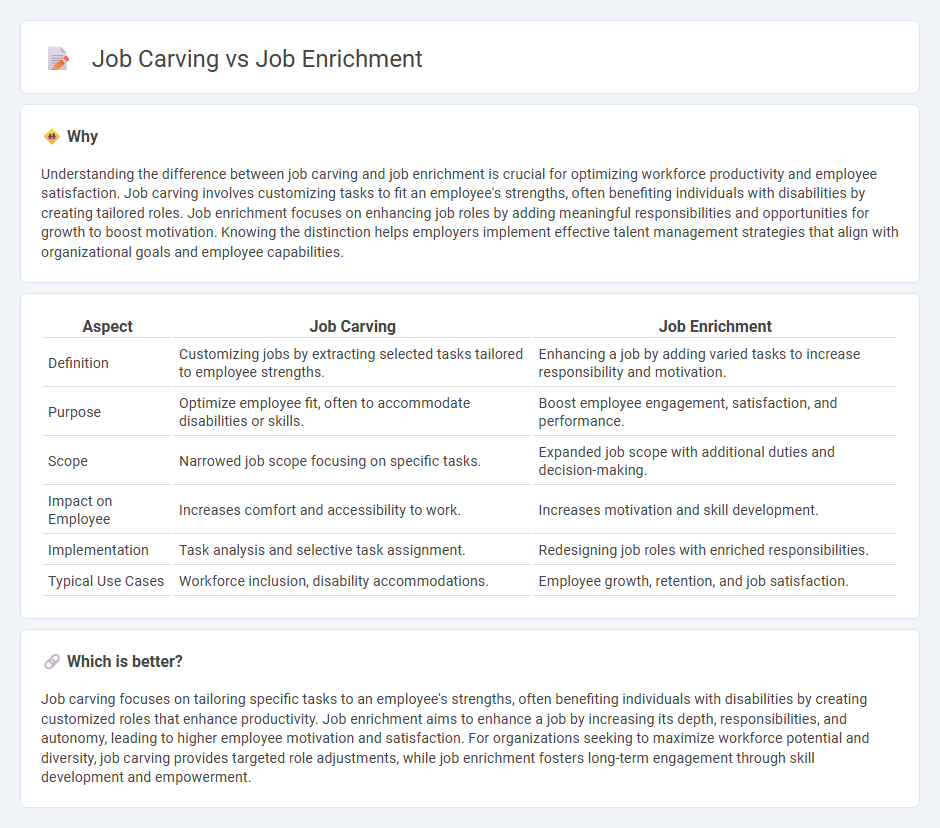
Job carving customizes roles by tailoring specific tasks to match an employee's strengths and preferences, enhancing productivity and job satisfaction. Job enrichment focuses on expanding job responsibilities to include planning, decision-making, and increased autonomy, fostering motivation and professional growth. Discover how these innovative employment strategies can transform workforce engagement and performance.
Why it is important
Understanding the difference between job carving and job enrichment is crucial for optimizing workforce productivity and employee satisfaction. Job carving involves customizing tasks to fit an employee's strengths, often benefiting individuals with disabilities by creating tailored roles. Job enrichment focuses on enhancing job roles by adding meaningful responsibilities and opportunities for growth to boost motivation. Knowing the distinction helps employers implement effective talent management strategies that align with organizational goals and employee capabilities.
Comparison Table
| Aspect | Job Carving | Job Enrichment |
|---|---|---|
| Definition | Customizing jobs by extracting selected tasks tailored to employee strengths. | Enhancing a job by adding varied tasks to increase responsibility and motivation. |
| Purpose | Optimize employee fit, often to accommodate disabilities or skills. | Boost employee engagement, satisfaction, and performance. |
| Scope | Narrowed job scope focusing on specific tasks. | Expanded job scope with additional duties and decision-making. |
| Impact on Employee | Increases comfort and accessibility to work. | Increases motivation and skill development. |
| Implementation | Task analysis and selective task assignment. | Redesigning job roles with enriched responsibilities. |
| Typical Use Cases | Workforce inclusion, disability accommodations. | Employee growth, retention, and job satisfaction. |
Which is better?
Job carving focuses on tailoring specific tasks to an employee's strengths, often benefiting individuals with disabilities by creating customized roles that enhance productivity. Job enrichment aims to enhance a job by increasing its depth, responsibilities, and autonomy, leading to higher employee motivation and satisfaction. For organizations seeking to maximize workforce potential and diversity, job carving provides targeted role adjustments, while job enrichment fosters long-term engagement through skill development and empowerment.
Connection
Job carving enhances employment by customizing roles to fit employees' strengths, increasing job satisfaction and productivity. Job enrichment improves employment quality through added responsibilities and skill development, motivating workers and reducing turnover. Both strategies connect by tailoring work environments to maximize employee engagement and efficiency, promoting sustainable employment practices.
Key Terms
Motivation
Job enrichment enhances motivation by increasing job responsibilities, autonomy, and opportunities for personal growth, leading to higher job satisfaction and engagement. Job carving, by contrast, tailors job duties to match individual strengths and interests, fostering motivation through personalized work roles and reducing task monotony. Explore detailed strategies and benefits of both approaches to optimize employee motivation and productivity.
Customization
Job enrichment enhances roles by adding varied responsibilities that increase employee motivation and skill use, leading to higher job satisfaction and productivity. Job carving customizes roles by tailoring specific tasks from existing jobs to fit an employee's unique strengths or limitations, optimizing workforce efficiency and inclusion. Explore deeper insights on how customization in job design can improve organizational performance and employee engagement.
Skill Utilization
Job enrichment enhances skill utilization by expanding an employee's responsibilities to include more challenging and meaningful tasks, promoting personal growth and job satisfaction. Job carving customizes roles by dissecting existing jobs to match specific skills of employees, optimizing the application of individual talents and increasing productivity. Explore these strategies further to understand how they can transform workforce effectiveness and employee engagement.
Source and External Links
Job Enrichment: A Practical Guide + 13 Examples - AIHR - Job enrichment involves adding motivators such as skill variety, task significance, and autonomy to existing roles to increase employee satisfaction, motivation, and work quality through interventions like creating natural work units and combining tasks.
What is job enrichment? - HiBob - Job enrichment is a motivational strategy that makes work more rewarding by giving employees greater responsibility, challenging tasks, more autonomy, and opportunities for growth to improve engagement and satisfaction.
Q&A: What Is Job Enrichment? | Indeed.com - Job enrichment is a technique that increases employee satisfaction by delegating additional responsibilities, benefiting both employees (motivation, skill acquisition, accomplishment) and employers (reduced absenteeism, turnover, and workload for management).
 dowidth.com
dowidth.com